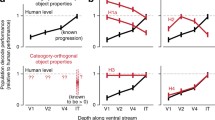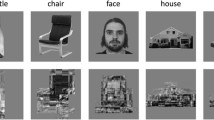Abstract
Visual object recognition in humans and nonhuman primates is achieved by the ventral visual pathway (ventral occipital-temporal cortex, VOTC), which shows a well-documented object domain structure. An on-going question is what type of information is processed in the higher-order VOTC that underlies such observations, with recent evidence suggesting effects of certain visual features. Combining computational vision models, fMRI experiment using a parametric-modulation approach, and natural image statistics of common objects, we depicted the neural distribution of a comprehensive set of visual features in the VOTC, identifying voxel sensitivities with specific feature sets across geometry/shape, Fourier power, and color. The visual feature combination pattern in the VOTC is significantly explained by their relationships to different types of response-action computation (fight-or-flight, navigation, and manipulation), as derived from behavioral ratings and natural image statistics. These results offer a comprehensive visual feature map in the VOTC and a plausible theoretical explanation as a mapping onto different types of downstream response-action systems.




Similar content being viewed by others
References
Felleman DJ, van Essen DC. Distributed hierarchical processing in the primate cerebral cortex. Cereb Cortex 1991, 1: 1–47.
Kriegeskorte N, Mur M, Ruff DA, Kiani R, Bodurka J, Esteky H, et al. Matching categorical object representations in inferior temporal cortex of man and monkey. Neuron 2008, 60: 1126–1141.
Kanwisher N. Functional specificity in the human brain: A window into the functional architecture of the mind. Proc Natl Acad Sci U S A 2010, 107: 11163–11170.
Konkle T, Caramazza A. Tripartite organization of the ventral stream by animacy and object size. J Neurosci 2013, 33: 10235–10242.
Grill-Spector K, Weiner KS. The functional architecture of the ventral temporal cortex and its role in categorization. Nat Rev Neurosci 2014, 15: 536–548.
Levy I, Hasson U, Avidan G, Hendler T, Malach R. Center-periphery organization of human object areas. Nat Neurosci 2001, 4: 533–539.
Hasson U, Levy I, Behrmann M, Hendler T, Malach R. Eccentricity bias as an organizing principle for human high-order object areas. Neuron 2002, 34: 479–490.
Bracci S, Op de Beeck H. Dissociations and associations between shape and category representations in the two visual pathways. J Neurosci 2016, 36: 432–444.
Kaiser D, Azzalini DC, Peelen MV. Shape-independent object category responses revealed by MEG and fMRI decoding. J Neurophysiol 2016, 115: 2246–2250.
Proklova D, Kaiser D, Peelen MV. Disentangling representations of object shape and object category in human visual cortex: The animate-inanimate distinction. J Cogn Neurosci 2016, 28: 680–692.
Bracci S, Ritchie JB, de Beeck HO. On the partnership between neural representations of object categories and visual features in the ventral visual pathway. Neuropsychologia 2017, 105: 153–164.
Peelen MV, Downing PE. Category selectivity in human visual cortex: Beyond visual object recognition. Neuropsychologia 2017, 105: 177–183.
Long B, Yu CP, Konkle T. Mid-level visual features underlie the high-level categorical organization of the ventral stream. Proc Natl Acad Sci USA 2018, 115: E9015–E9024.
Nasr S, Echavarria CE, Tootell RB. Thinking outside the box: Rectilinear shapes selectively activate scene-selective cortex. J Neurosci 2014, 34: 6721–6735.
Perrinet LU, Bednar JA. Edge co-occurrences can account for rapid categorization of natural versus animal images. Sci Rep 2015, 5: 11400.
Long B, Störmer VS, Alvarez GA. Mid-level perceptual features contain early cues to animacy. J Vis 2017, 17: 20.
Yue X, Pourladian IS, Tootell RB, Ungerleider LG. Curvature-processing network in macaque visual cortex. PNAS 2014, 111: E3467–E3475.
Rosenthal I, Ratnasingam S, Haile T, Eastman S, Fuller-Deets J, Conway BR. Color statistics of objects, and color tuning of object cortex in macaque monkey. J Vis 2018, 18: 1.
Lafer-Sousa R, Conway BR, Kanwisher NG. Color-biased regions of the ventral visual pathway lie between face- and place-selective regions in humans, as in macaques. J Neurosci 2016, 36: 1682–1697.
Lafer-Sousa R, Conway BR. Parallel, multi-stage processing of colors, faces and shapes in macaque inferior temporal cortex. Nat Neurosci 2013, 16: 1870–1878.
Chang L, Bao P, Tsao DY. The representation of colored objects in macaque color patches. Nat Commun 2017, 8: 2064.
Bryan PB, Julian JB, Epstein RA. Rectilinear edge selectivity is insufficient to explain the category selectivity of the parahippocampal place area. Front Hum Neurosci 2016, 10: 137.
Mahon BZ, Caramazza A. What drives the organization of object knowledge in the brain? Trends Cogn Sci 2011, 15: 97–103.
Abboud S, Maidenbaum S, Dehaene S, Amedi A. A number-form area in the blind. Nat Commun 2015, 6: 6026.
Bi YC, Wang XY, Caramazza A. Object domain and modality in the ventral visual pathway. Trends Cogn Sci 2016, 20: 282–290.
Osher DE, Saxe RR, Koldewyn K, Gabrieli JD, Kanwisher N, Saygin ZM. Structural connectivity fingerprints predict cortical selectivity for multiple visual categories across cortex. Cereb Cortex 2016, 26: 1668–1683.
Bouhali F, Thiebaut de Schotten M, Pinel P, Poupon C, Mangin JF, Dehaene S, et al. Anatomical connections of the visual word form area. J Neurosci 2014, 34: 15402–15414.
Mahon BZ, Milleville SC, Negri GA, Rumiati RI, Caramazza A, Martin A. Action-related properties shape object representations in the ventral stream. Neuron 2007, 55: 507–520.
Chen QJ, Garcea FE, Almeida J, Mahon BZ. Connectivity-based constraints on category-specificity in the ventral object processing pathway. Neuropsychologia 2017, 105: 184–196.
Stevens WD, Tessler MH, Peng CS, Martin A. Functional connectivity constrains the category-related organization of human ventral occipitotemporal cortex. Hum Brain Mapp 2015, 36: 2187–2206.
Hutchison RM, Culham JC, Everling S, Flanagan JR, Gallivan JP. Distinct and distributed functional connectivity patterns across cortex reflect the domain-specific constraints of object, face, scene, body, and tool category-selective modules in the ventral visual pathway. Neuroimage 2014, 96: 216–236.
Kourtzi Z, Connor CE. Neural representations for object perception: Structure, category, and adaptive coding. Annu Rev Neurosci 2011, 34: 45–67.
Zachariou V, Del Giacco AC, Ungerleider LG, Yue XM. Bottom-up processing of curvilinear visual features is sufficient for animate/inanimate object categorization. J Vis 2018, 18: 3.
Canny J. A computational approach to edge detection. IEEE Transactions on Pattern Analysis and Machine Intelligence 1986, PAMI-8: 679–698.
Krüger N. Learning object representations using a priori constraints within ORASSYLL. Neural Comput 2001, 13: 389–410.
Rajimehr R, Devaney KJ, Bilenko NY, Young JC, Tootell RB. The “parahippocampal place area” responds preferentially to high spatial frequencies in humans and monkeys. PLoS Biol 2011, 9: e1000608.
Nasr S, Tootell RB. A cardinal orientation bias in scene-selective visual cortex. J Neurosci 2012, 32: 14921–14926.
Goffaux V, Duecker F, Hausfeld L, Schiltz C, Goebel R. Horizontal tuning for faces originates in high-level Fusiform Face Area. Neuropsychologia 2016, 81: 1–11.
Canário N, Jorge L, Loureiro Silva MF, Alberto Soares M, Castelo-Branco M. Distinct preference for spatial frequency content in ventral stream regions underlying the recognition of scenes, faces, bodies and other objects. Neuropsychologia 2016, 87: 110–119.
Berman D, Golomb JD, Walther DB. Scene content is predominantly conveyed by high spatial frequencies in scene-selective visual cortex. PLoS One 2017, 12: e0189828. https://doi.org/10.1371/journal.pone.0189828.
Brouwer GJ, Heeger DJ. Decoding and reconstructing color from responses in human visual cortex. J Neurosci 2009, 29: 13992–14003.
Yan CG, Wang XD, Zuo XN, Zang YF. DPABI: data processing & analysis for (resting-state) brain imaging. Neuroinformatics 2016, 14: 339–351.
Wang XY, Peelen MV, Han ZZ, He CX, Caramazza A, Bi YC. How visual is the visual cortex? comparing connectional and functional fingerprints between congenitally blind and sighted individuals. J Neurosci 2015, 35: 12545–12559.
Hair JF, Black WC, Babin BJ, Anderson RE. Multivariate data analysis. Pearson New International Edition. Edinburgh Gate Harlow: Pearson Education Limited, 2014: 200–201.
Downing PE, Chan AWY, Peelen MV, Dodds CM, Kanwisher N. Domain specificity in visual cortex. Cereb Cortex 2006, 16: 1453–1461.
Moreno-Martínez FJ, Montoro PR. An ecological alternative to Snodgrass & Vanderwart: 360 high quality colour images with norms for seven psycholinguistic variables. PLoS One 2012, 7: e37527. https://doi.org/10.1371/journal.pone.0037527.
Brodeur MB, Guérard K, Bouras M. Bank of Standardized Stimuli (BOSS) phase II: 930 new normative photos. PLoS One 2014, 9: e106953. https://doi.org/10.1371/journal.pone.0106953.
Tang N, Ding YF, Zhang W, Hu J, Xu XH. Stay active to cope with fear: A cortico-intrathalamic pathway for conditioned flight behavior. Neurosci Bull 2019, 35: 1116–1119.
Thorat S, Proklova D, Peelen MV. The nature of the animacy organization in human ventral temporal cortex. Elife 2019, 8: e47142.
He CX, Peelen MV, Han ZZ, Lin N, Caramazza A, Bi YC. Selectivity for large nonmanipulable objects in scene-selective visual cortex does not require visual experience. Neuroimage 2013, 79: 1–9.
Wang XY, He CX, Peelen MV, Zhong SY, Gong GL, Caramazza A, et al. Domain selectivity in the parahippocampal gyrus is predicted by the same structural connectivity patterns in blind and sighted individuals. J Neurosci 2017, 37: 4705–4716.
Troiani V, Stigliani A, Smith ME, Epstein RA. Multiple object properties drive scene-selective regions. Cereb Cortex 2014, 24: 883–897.
Bao PL, She L, McGill M, Tsao DY. A map of object space in primate inferotemporal cortex. Nature 2020, 583: 103–108.
Lescroart MD, Stansbury DE, Gallant JL. Fourier power, subjective distance, and object categories all provide plausible models of BOLD responses in scene-selective visual areas. Front Comput Neurosci 2015, 9: 135.
Caldara R, Seghier ML, Rossion B, Lazeyras F, Michel C, Hauert CA. The fusiform face area is tuned for curvilinear patterns with more high-contrasted elements in the upper part. Neuroimage 2006, 31: 313–319.
Bracci S, Ritchie JB, Kalfas I, Op de Beeck HP. The ventral visual pathway represents animal appearance over animacy, unlike human behavior and deep neural networks. J Neurosci 2019, 39: 6513–6525.
Sha L, Haxby JV, Abdi H, Guntupalli JS, Oosterhof NN, Halchenko YO, et al. The animacy continuum in the human ventral vision pathway. J Cogn Neurosci 2015, 27: 665–678.
Long B, Konkle T. The role of textural statistics vs outer contours in deep CNN and neural responses to objects. 2018 Conference on Cognitive Computational Neuroscience, Philadelphia, Pennsylvania, USA: Cognitive Computational Neuroscience, 2018. https://doi.org/10.32470/CCN.2018.1118-0.
Harris A, Aguirre GK. Neural tuning for face wholes and parts in human fusiform gyrus revealed by FMRI adaptation. J Neurophysiol 2010, 104: 336–345.
Zeiler MD, Fergus R. Visualizing and Understanding Convolutional Networks. Computer Vision – ECCV 2014, Cham: Springer International Publishing, 2014: 818–833.
Acknowledgements
This work was supported by the National Natural Science Foundation of China (31671128, 31925020, 31700999, 31700943, and 31500882), the Changjiang Scholar Professorship Award (T2016031), and Fundamental Research Funds for the Central Universities (2017EYT35). We thank Shiguang Shan for discussions about computational vision models, and Joshua B. Julian for generously sharing codes for the right-angle and curvature computations.
Author information
Authors and Affiliations
Corresponding author
Ethics declarations
Conflict of interest
The authors claim that there are no conflicts of interest.
Supplementary Information
Below is the link to the electronic supplementary material.
Rights and permissions
About this article
Cite this article
Fan, S., Wang, X., Wang, X. et al. Topography of Visual Features in the Human Ventral Visual Pathway. Neurosci. Bull. 37, 1454–1468 (2021). https://doi.org/10.1007/s12264-021-00734-4
Received:
Accepted:
Published:
Issue Date:
DOI: https://doi.org/10.1007/s12264-021-00734-4




